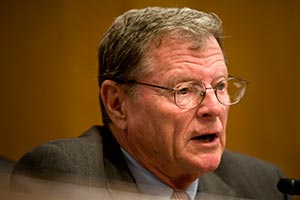Senior Reporter
Sen. James Inhofe: EPW ‘Nearly Done’ Preparing Long-Term Highway Bill

WASHINGTON — Sen. James Inhofe, transportation policy committee chairman, said he’s “nearly done crafting a bill” that would authorize highway programs for five or six years.
Addressing reporters outside of the U.S. Capitol on April 15, the Oklahoma Republican indicated the legislation likely would be considered before federal highway funding authority expires May 31. The outstanding issues with the legislation, he noted, continue to be identifying a sustainable source of funding for a major highway account and getting GOP colleagues with strong conservative ideologies to back the measure.
To resolve those concerns, Inhofe indicated he’s had productive conversations with Sen. Orrin Hatch (R-Utah), chairman of the tax-writing Finance Committee — a panel with jurisdiction over the Highway Trust Fund. But Hatch and his House counterpart, Rep. Paul Ryan (R-Wis.), have yet to say how they would boost the trust fund.
And regarding his fellow Republicans, Inhofe said: “What they don’t realize is that … the only alternative to a highway reauthorization bill is a short-term extension that costs about 30% more — clearly ours is the conservative approach to it.”
Sen. Barbara Boxer of California, the top Democrat on the EPW committee, confirmed to Transport Topics that her camp and Inhofe were “close to an agreement” on a long-term bill. Boxer said she would back most funding proposals for the bill but downplayed the likelihood of passing the measure as part of a comprehensive tax reform package later this year.
While most transportation groups have called on Congress to advance a long-term highway measure, several industry leaders, such as American Road and Transportation Builders Association President and CEO Pete Ruane, say they expect lawmakers to approve a short-term funding patch prior to the May deadline.
“I think it’s going to be a fairly short one,” Ruane told reporters, adding, “The good news is [a transportation plan] is in front of them. They’re seriously looking at it, and they’re going to do something.”

